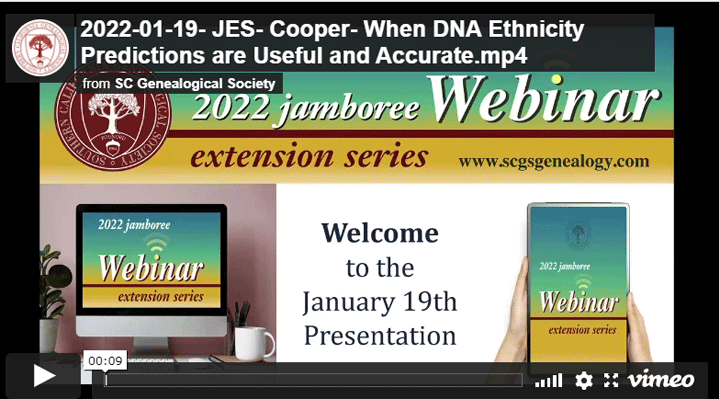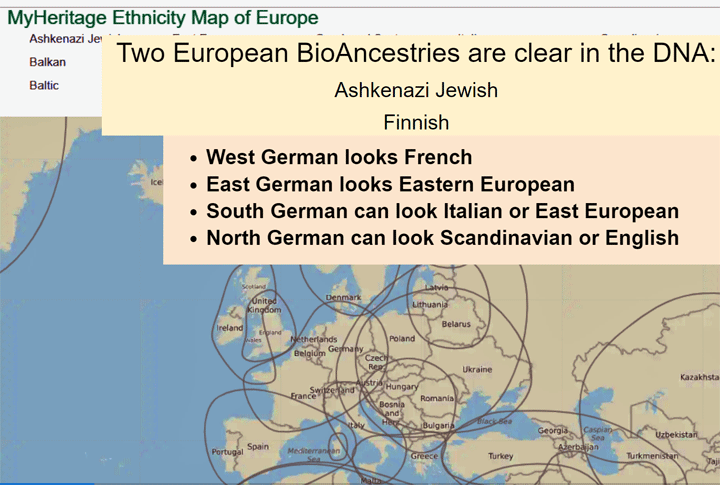The interpretation of the origins of your ancestors from your DNA is called different things by different companies: ancestry composition, admixture, or, incorrectly, ethnicity. The latter term is borrowed from anthropology and refers to a shared cultural heritage and does not necessarily include shared DNA although it often will. Click here for the definition of ethnicity online. Ann Turner and Debbie Kennett, two genetic genealogists I admire, both like the word bioancestry instead of ethnicity, so that is the word I will attempt to use from now on.
I did a recent talk for the Southern California Genealogy Society’s (SCGS) webinar series on why the predictions vary so much from company to company and whether they are at all accurate. The slides are here and the webinar, free to SCGS members, is archived here (log in to view it). Click here for the schedule of SCGS webinars.
I explained that each company has different reference populations and they were originally focused on Europeans. I suggested reading the article at the ISOGG wiki (click here). I discussed that our ancestors moved around more than you might realize so that bioancestry predictions are not accurate at a country level. Your admix can mainly be determined on a macro scale: the North, South, East, and West of each continent. Some populations were isolated and inbred and thus are easier to predict from the DNA.
My own puzzle is why I see no German when my mother was born in Munich and her mother was Bavarian. The answer is that Germany was a crossroads, thus invaded and repopulated by many countries in the last 500 years. I used a lovely map from MyHeritage for a slide in my talk showing the overlapping bioancestries in Europe (under DNA click DNA tools and then Ethnicities Map to see more maps)
A friend on FaceBook told me I was very brave to do a presentation on this subject! I think it is important to let people know that the oddities in admixture predictions do not mean that the relative predictions are inaccurate. However a very strange bioancestry prediction, that is backed up by matching others from that area, is worth following up on.


I tell everyone interested that every web site will give them different results for their ancestry (bioancestry). Gedmatch has many databases to try. One specified an exact island as the source of part of my wife’s DNA ancestry. I think it was south of Australia but have forgotten the location. No other data base has shown anything like that.
One of my probable Ingalls descendant cousins is quite sure that she has American Indian ancestry because of family stories and documented capture of a female ancestor by Indians. One database said she is 5 percent Indian and another says none!
I have one wrong-but-insightful assignment at one company. They say I have some input from what is now Croatia. Fortunately I had been reading up on the Wends/Sorbs (Wendish Society here in Australia says they are the same.) It seems while some settled SE of Berlin into Saxony, others went south – and the latter are the ones included in a panel for Croatia. I knew of and had seen Wendish families near my grandparents. And of course these days everyone is fairly mixed. But my ancestral surnames did not seem to contain any Wendish ones. The bioancestry tells me there is some Wendish somewhere.
I would not have known this but for a happy (apparent) mistake!
One good way to find out about this stuff is on forums and from colleagues at family history societies. I am looking towards more chances this year to see people face to face and discuss such things.
Hi Kitty,
Great presentation and slide to demonstrate your introduction to the term bioancestry (bio-ancestry, bioAncestry, etc). I am including a link to this article in all my presentations and handouts.
In your slides I want to call your attention to Slide 51 re JTest. The author, Davidski, in his updated blog entry 19/03/2018 says:
“My most important point is: don’t use this Jtest.
This was what the project creator himself, Davidski, had to say about it in 2018.
This test was only supposed to be a fun experiment…And even as fun experiments with ADMIXTURE go, it’s now horribly outdated.”
Here is the link: https://bga101.blogspot.com/2012/09/eurogenes-ashkenazim-ancestry-test-files.html
I am interested in your reaction to the article update and current use of the JTest and if you would not use it, what on GEDmatch could give added incite to Ash Jewish identity?
Regards and thanks for all your work, I have been following your blog since 2017 and especially appreciate all your entries regarding your AshJewish bioancestry!
Arthur Sissman
Naples FL
Jewish Genealogy SIG of Collier/Lee Co FL
Join our FB page at Jewish Genealogy SIG: https://www.facebook.com/groups/hellojewishgen
Genealogy Wise page: http://www.genealogywise.com/profile/ArthurSissman
Researching: ZISMAN/ZYSMAN/ZUSMAN (Belarus); TELESHEVSKY (Belarus); CHANUTIN, (W. Russia), BRODY, (Hungary); FRIEDMAN, (Hungary); GRAUBARD, AARONSON (Romania/Ukraine)
Thanks for pointing that out Arthur, apologies if I did not mention that in my talk. I find the gedmatch Jtest calculator only useful for people who are wondering if they have any jewish ancestry. See this slide from another older talk and the next slide
https://slides.com/kittycooper/gedmatch#/12/0/1
I will remove your contact info from the comment as it is likely to generate spam for you!
Thank you for raising the subject of the term ethnicity. I have preached against this for many years. That term is a social construct and not a scientific one. There’s a post on my blog, and I do think I was the first genetic genealogist to state this. Sadly there are too many well-known genetic genealogist who continue to use ethnicity, stating that the general public understands it and many of the testing companies still use it. How sad that we can’t teach the public correctly. Isn’t our purpose to teach public?
Thank you again!!!
Emily
Thanks so much Emily, I could not find the blog post you are referring to, please post the URL for it.